The Stratocaster by Squier and Fender, and the SG by Epiphone and Gibson, are two very popular and iconic electric guitar models. In this article, I’ll compare the specifications, tone, look, feel, and specific design differences of each guitar, and also take an in-depth look at the full ranges by the four brands, so you can see what models are available under your budget.
The Quick Answer
The Stratocaster sounds brighter and crisper than the SG which sounds warmer. The Gibson/ Epiphone SG is often preferred for rock and metal, whilst the Fender/ Squier Strat is often better for cleaner tones. The Stratocaster has three single coil pickups and the SG has two humbucker pickups.
Comparing Models
First. let’s take a look at the design of the two guitars and how their features differ.
Fender Stratocaster and Gibson SG
Here is a table comparing the Fender American Professional Stratocaster and Gibson SG Standard electric guitar models. Keep in mind that these are just two similarly priced versions of the guitars, and the specifications will vary depending on the exact model in each range, I’ll go through this a bit later in the article.
| Feature | Fender Stratocaster | Gibson SG |
| Body Shape | Double Cutaway | Double Cutaway |
| Body Wood | Alder | Mahogany |
| Pickups | Three Single-Coils | Two Humbuckers |
| Neck Shape | C-Shape | Rounded |
| Neck Wood | Maple | Mahogany |
| Neck Construction | Bolt-On | Set-Neck |
| Frets | 22 | 22 |
| Fretboard Wood | Rosewood or Maple | Rosewood |
| Scale Length | 25.5” | 24.75” |
| Bridge | Synchronised Tremolo | Fixed |
| Number of Tone Knobs | 2 | 2 |
| Number of Volume Knobs | 1 | 2 |
| Pickup Selector | 5-way | 3-way |
| Weight | 8 pounds (3.6 kg) | 6 pounds (2.7 kg) |
Squier Stratocaster and Epiphone SG
Here is a table comparing the more affordable Squier and Epiphone versions of these guitars. Again, this is just a comparison between two standard models in the range (Squier Classic Vibe 60’s Stratocaster and Epiphone SG Standard), and the features will vary depending on the exact model you choose.
| Feature | Squier Stratocaster | Epiphone SG |
| Body Shape | Double Cutaway | Double Cutaway |
| Body Wood | Nato | Mahogany |
| Pickups | Three Single-Coils | Two Humbuckers |
| Neck Shape | Slim C-shape | 60’s Slim Taper |
| Neck Wood | Maple | Mahogany |
| Neck Construction | Bolt-On | Set-Neck |
| Frets | 21 | 22 |
| Fretboard Wood | Indian Laurel or Maple | Indian Laurel |
| Scale Length | 25.5” | 24.75” |
| Bridge | Synchronised Tremolo | Fixed |
| Number of Tone Knobs | 2 | 2 |
| Number of Volume Knobs | 1 | 2 |
| Pickup Selector | 5-way | 3-way |
| Weight | 7.3 pounds (3.3 kg) | 6.3 pounds (2.9 kg) |
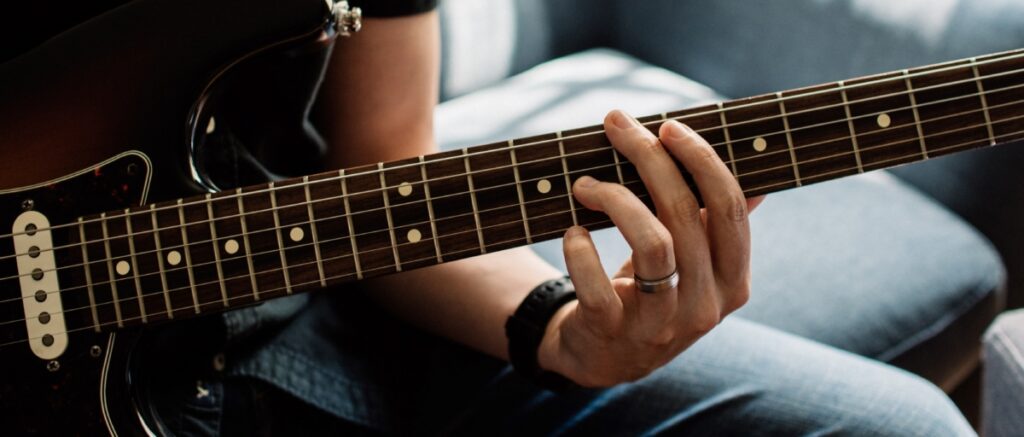
How Do They Sound?
The Stratocaster and SG have very different signature tones, making them more suitable for different music styles than others.
The Stratocaster sounds brighter and crisper than the SG due to its three single coil pickups. The SG sounds warmer and louder than the Stratocaster, as it has two humbucker pickups, this also means the SG suffers less from feedback and humming when using distorted amplifier settings.
In addition to the pickup differences, other design aspects also give the guitars unique tones:
- The mahogany body of the SG produces a darker and warmer sound than the alder body on the Strat.
- The set neck construction on the SG causes the tone to transfer better between the neck and body compared to the bolt-on construction that the Stratocaster has. This makes the SG sound warmer and fuller.
- The shorter scale length on the SG also contributes to the warmer and deeper tone.
- The Stratocaster has a tremolo arm which allows you adjust the pitch and create a vibrato effect, whereas the SG has a fixed bridge so does not feature a tremolo.
Check out my article comparing 24.75″ and 25.5″ scale guitars to learn more.
I’ll go into the differences between the controls present on each guitar a bit later on in the article, but this also does affect the versatility and types of tone you can achieve. The Stratocaster has a 5-way pickup selector giving you plenty of options to tweak how bright/ warm the tone sounds. The SG has a 3-way pickup selector, but independent volume and tone controls for each pickup, giving you some interesting options to play about with.
Here is a video where you can hear the sounds of both guitars using clean and distorted amp settings. It’s set to start at the correct moment in the video so you can just hit play.
Look and Feel
It’s also important to consider the look and feel of the guitar, to make sure it’s an instrument you actually enjoy using. Both guitars have a double cutaway design, but most would agree, they look very different.
Differences:
- The SG is lighter than the Stratocaster due to its slimmer body (around 6 pounds compared to 8 pounds).
- The Stratocaster usually has a slightly slimmer neck, which may feel more comfortable for smaller handed players. However, the neck shape will vary from model to model.
- The SG has a shorter scale length than the Stratocaster (24.75″ compared to 25.5″).
- The Stratocaster has a 3+3 headstock configuration, and the Stratocaster has a 6 in-line headstock design.
- The SG has a flatter body compared to the Strat which has a more contoured shape, which some players prefer as it helps the guitar to sit closer to the body.
- The SG has a very symmetrical body shape, causing the centre of gravity to sit lower on the guitar, meaning it will tilt downwards more when playing stood up.
Here is a diagram comparing the two guitars. The differences are in black text on the outside of the image, and the similarities are in green text in the centre.
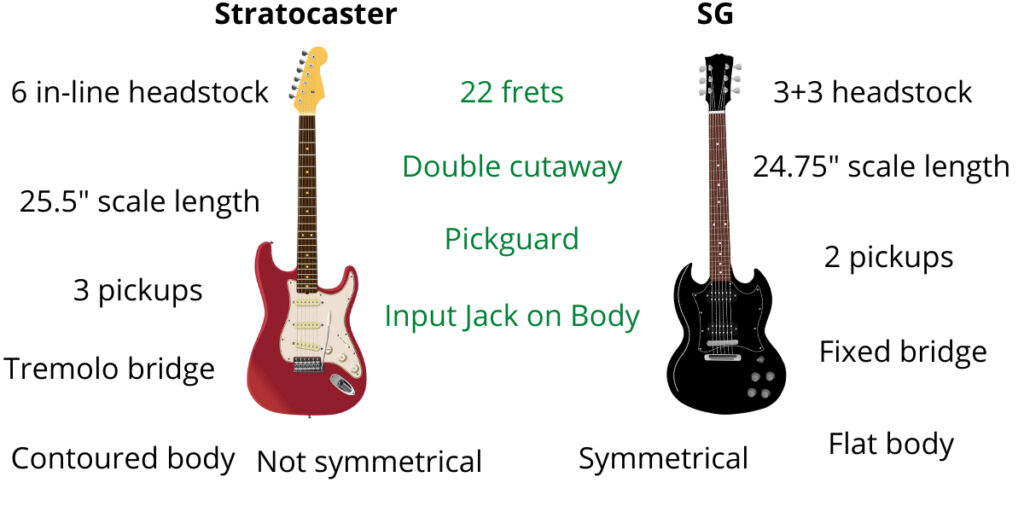
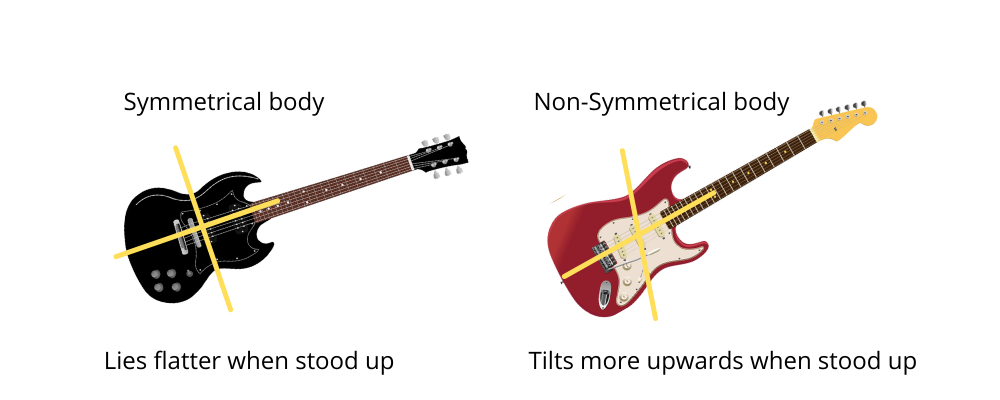
Check out my complete comparison between the Stratocaster and Telecaster
Comparing the Ranges
Before I jump into the specific design differences between the two guitars in-depth, I wanted to look at the full ranges of the SG and Stratocaster.
I’ve made some tables to show pretty much every standard Stratocaster by Squier and Fender, and SG by Gibson and Epiphone in the ranges. The tables are split into price brackets and are all in order from the lowest to the highest price so you can quickly identify the models in your budget. The prices are all from Guitar Center at the time of writing. Make sure you scroll sideways if you’re on mobile to see all the features.
Guitar Center are always the first place I look at when I’m interested in a new electric guitar because have a huge range of models for sale and always have some excellent deals on. Here’s a link to take you directly to Guitar Center’s electric guitar range so you can see all the offers available at the moment.
Entry-Level and Low-End (under $500)
| Guitar | Origin | Body Wood | Construction | Neck Shape | Price |
| Squier Bullet Stratocaster | Indonesia | Basswood | Bolt-On | C-shape | $180 |
| Epiphone SG Special Satin E1 | China | Poplar | Bolt-On | 60s SlimTaper D | $180 |
| Squier Affinity Stratocaster | China | Alder | Bolt-On | Modern-C | $230 |
| Epiphone SG Classic Worn P90’s | China | Mahogany | Set-Neck | 60s SlimTaper | $380 |
| Squier Contemporary Stratocaster | China | Poplar | Bolt-On | C-shape | $400 |
| Epiphone SG Special P-90 | China | Mahogany | Set-Neck | 60s SlimTaper | $400 |
| Epiphone SG Muse | China | Mahogany | Set-Neck | C-shape | $429 |
| Squier Classic Vibe Stratocaster | Indonesia | Poplar/ Pine | Bolt-On | C/ Slim-C | $430 |
| Epiphone SG Traditional Pro | China | Mahogany | Set-Neck | SlimTaper | $450 |
| Epiphone SG Standard | China | Mahogany | Set-Neck | 60s SlimTaper | $450 |
Mid-Range ($500-$1200)
Note: there is no column for neck construction in the mid-range table as all the Stratocasters have a bolt-on neck, and all SGs have a set-neck in this price brackets.
| Guitar | Origin | Body Wood | Neck Shape | Price |
| Epiphone SG Modern | China | Mahogany | Asymmetrical SlimTaper | $550 |
| Epiphone SG Custom | China | Mahogany | SlimTaper | $580 |
| Fender Player Stratocaster | Mexico | Alder | Modern C | $750 |
| Epiphone SG Prophecy | China | Mahogany | Asymmetric | $900 |
| Fender Deluxe Stratocaster | Mexico | Alder | Modern C | $950 |
| Fender Vintera Stratocaster | Mexico | Alder | C or Soft-V | $950 |
| Gibson SG Tribute | America | Mahogany | Rounded | $1100 |
| Fender Boxer Strat | Japan | Basswood | Thin C | $1200 |
High-End (over $1200)
Note: there is no column for neck construction in the high-end table, as all the Stratocasters have a bolt-on neck, and all SGs have a set-neck in these price brackets. All these guitars are made in America.
| Guitar | Body Wood | Neck | Price | |
| Fender American Performer Strat | Alder | Modern C | $1200 | |
| Gibson SG Junior P90 | Mahogany | SlimTaper | $1400 | |
| Gibson SG Special | Mahogany | SlimTaper | $1500 | |
| Fender American Professional Strat | Alder | C-shape | $1500 | |
| Gibson SG Standard | Mahogany | Rounded | $1500 | |
| Fender American Showcase Strat | Alder | C-shape | $1700 | |
| Gibson SG Standard ‘61 | Mahogany | SlimTaper | $1800 | |
| Fender American Ultra Strat | Alder | Soft V/ Thick C | $1900 | |
| Gibson SG Modern | Mahogany | SlimTaper Asymmetric | $2000 | |
| Fender American Original Strat | Alder | D-shape | $2000 |
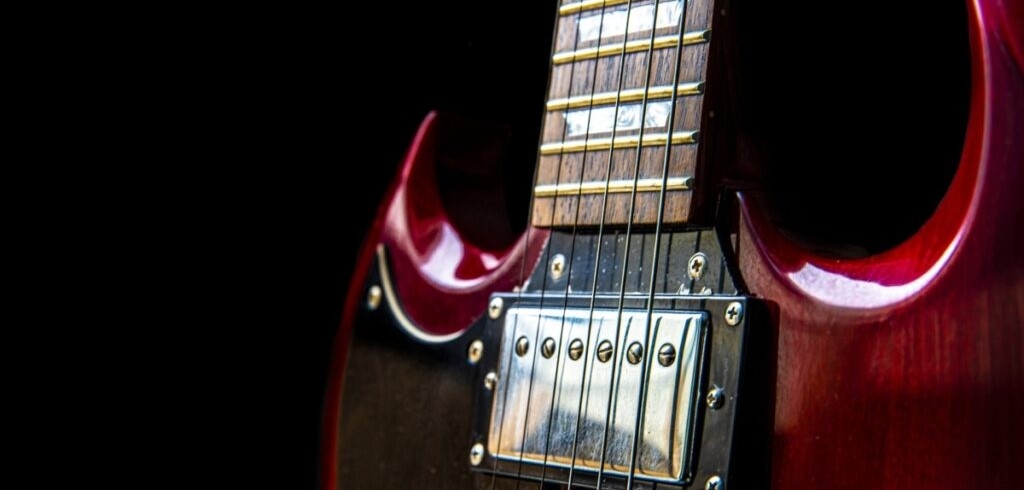
Specific Design Comparisons
Now we’ve been through the ranges, I wanted to take a more in-depth look at the specific features and design differences and similarities on each guitar. These all have an impact on the look, feel, or sound of the instruments.
Body
The Stratocaster and SG both have a double cutaway design. However, the SG is thinner, meaning its a lighter guitar, and also has a more symmetrical shape. The Stratocaster has a contoured body compared to the SG and its asymmetrical double cutaway body means the guitar tilts upwards at the headstock more when playing stood up.
The SG has a mahogany body, whereas the Stratocaster has an alder or ash body. The mahogany on the SG contributes to its darker and warmer tone compared to the Strat.
Neck
The SG has a mahogany neck set-neck, and the Stratocaster has a bolt-on maple neck. This means the SG has more resonance and a warmer tone by comparison. The shorter scale length on the SG also contributes to its more mellow sound.
The SG and Stratocaster both have a 22 fret neck. The Stratocasters fretboard is usually made out of either maple of rosewood, whereas the SG’s fretboard is made from Rosewood primarily, and sometimes Indian Laurel.
In terms of the neck shape, the Stratocaster has a slimmer C-shape compared to the more rounded SG on the flagship American models. Whilst most Stratocasters have a C-shape neck, the neck shape varies more throughout the SG range, with some opting for a rounded shape, and others having a slim-tapered neck.
Pickups
The most noticeable difference in tone comes from the pickups used on the SG and Stratocaster. The Stratocaster has a bright sounding 3-single coil pickup configuration, whereas the SG has two warmer and darker sounding humbuckers. The SG’s humbuckers make it more suitable for high gain as they are less susceptible to feedback. The higher output humbuckers also make the SG a louder guitar than the Stratocaster.
Some Stratocasters have a humbucker in the bridge position, or even two humbuckers, as seen on the Fender Boxer Stratocasters. The SG’s usually only have two humbuckers, but there are some models which have P90 pickups instead such as the SG Special.
Controls
The Stratocaster has a 5-way pickup selector, two tone controls and a volume control. The SG has a 3-way pickup selector, two tone controls, and two volume controls.
The 5-way pickup selector on the Stratocaster giving you access to different pickups in isolation, or combination, is what makes the tone of the Strat quite versatile, allowing you to go from very bright, to warmer sounds. Although the SG only has a 3-way pickup selector, the independent volume and tone controls for each pickup allow you to switch between clean/ crunch or lead/ rhythm tones very quickly and easily.
I’ve written full guides on the controls on both guitars if you want to learn a bit more:
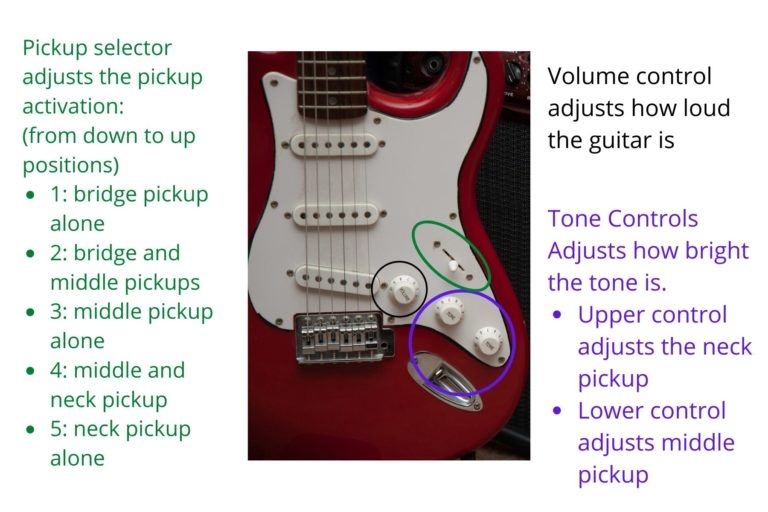
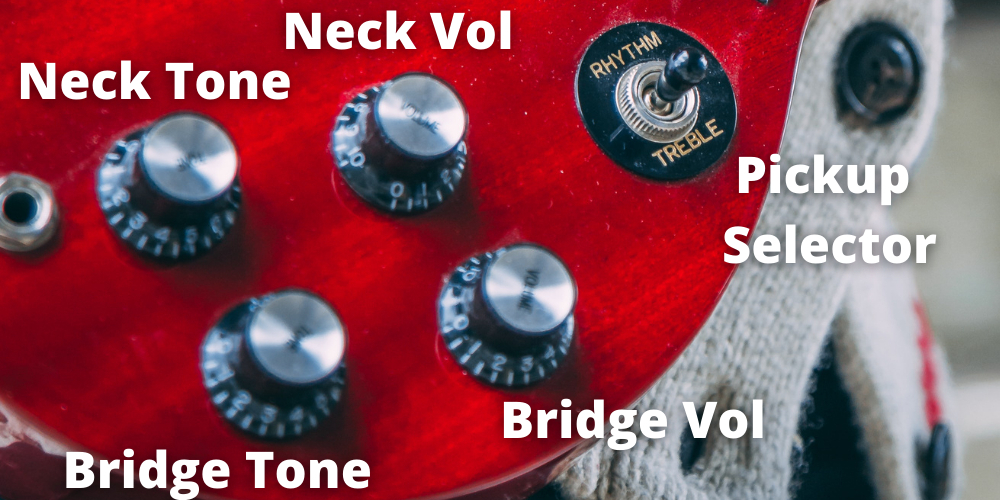

Bridge
The Stratocaster has a synchronised tremolo bridge which allows you to use the tremolo arm to add a vibrato effect to your playing. The SG has a fixed tune-o-matic bridge which does not have a tremolo arm, but stays in tune a bit better.
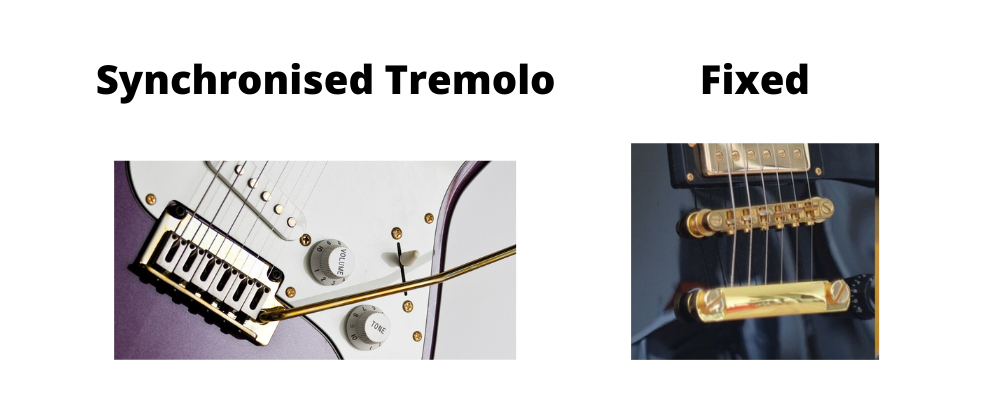
Which Should You Choose?
The best way to decide which guitar is best for you, is to head down to your local guitar store and give them both a try. Even if you’re a complete beginner, you can sit and stand with the guitar to get a feel for which is the most comfortable, and then ask the store assistants to play you a few riffs on each. With that said though, here are a couple of key points to help you make your decision:
- Stratocasters sound brighter and generally suit cleaner tones more, making them a better option for jazz and country music.
- SG guitars sound warmer, fuller, and less susceptible to feedback than Stratocasters when using high gain amp settings. This often makes SG models better for metal and heavy rock.
For Beginners?
For complete beginners, Stratocasters are usually chosen over SG guitars because they are more readily available for lower budgets and have more colour options. Both guitars are versatile, but for new guitarists looking to play metal and heavy rock, the SG is usually the better option.
I’ve written a complete buyer’s guide for electric guitars which takes you through all the things you need to consider and a step-by-step method to narrowing down your selection and choosing the best option. Here is a link to the article.
Here are some more articles you might find useful:
